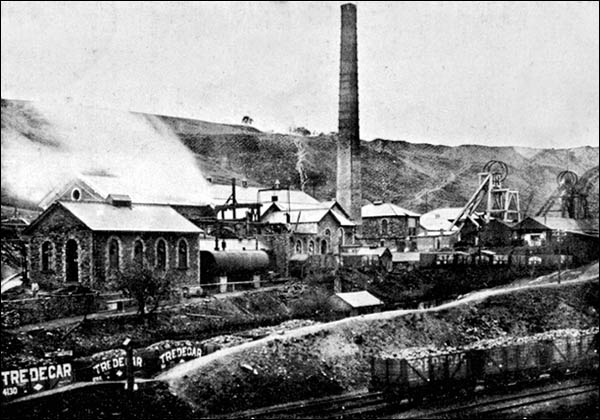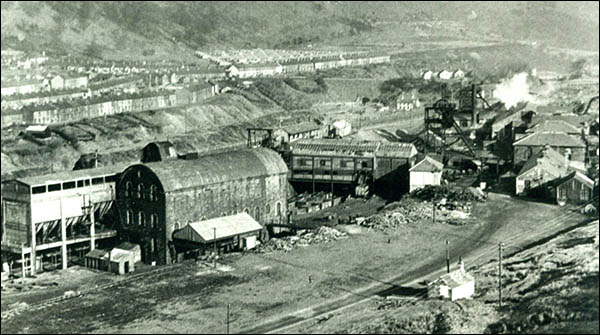Site of Tŷ Trist Colliery, Tredegar
The old pithead wheels displayed here commemorate the collieries of the Tredegar district. Tŷ Trist Colliery had two shafts a little south of the playing fields. Associated coke ovens and railway sidings covered the area where you now see the fields. The photo of the site c.1910 looks up the valley, the 1950 photo down the valley.
 The Tredegar Iron & Coal Company also owned Whitworth colliery. Tredegar Sports Centre stands on part of that colliery’s site.
The Tredegar Iron & Coal Company also owned Whitworth colliery. Tredegar Sports Centre stands on part of that colliery’s site.
Coalmining in the district started at “patches”, where coal and iron ore were within a metre or two of the surface. The first record of patch working at Bryn Bach, Tredegar, dates from 1747, when John Griffiths of Pontypool transported ironstone and coal by mule to Brecon, Clydach and Dowlais. Coal and ore were dug out from “bell pits” – bell-shaped in cross section and accessed by ladder or rope.
Coalmining accelerated after the Sirhowy ironworks opened in 1778 and Tredegar ironworks in 1800. Colliery levels, driven into the ground from the surface, enabled coal to be removed in drams or trams (primitive railway wagons). Construction of the Bryn Oer Tramroad in 1815 took coal from Bryn Oer, near Tafarnaubach, to the canal at Talybont.
Tredegar’s first deep pit, Duke Pit, was sunk in 1806. Dukestown was named after it. Isambard Kingdom Brunel preferred Tredegar steam coal for his ships including the Great Britain and Great Eastern, the world’s largest ships in their day.
 By the start of the 20th century, Tredegar’s main pits were Tŷ Trist (opened 1834), Bedwellty Pits (1853), Whitworth (1875), and Pochin (1876). Aneurin Bevan, founder of the NHS, once worked at Tŷ Trist and Pochin. His mentor, Walter Conway, was a miner at Pochin. Ray Reardon worked at Tŷ Trist and practised snooker at the Workmen’s Hall before making snooker his profession.
By the start of the 20th century, Tredegar’s main pits were Tŷ Trist (opened 1834), Bedwellty Pits (1853), Whitworth (1875), and Pochin (1876). Aneurin Bevan, founder of the NHS, once worked at Tŷ Trist and Pochin. His mentor, Walter Conway, was a miner at Pochin. Ray Reardon worked at Tŷ Trist and practised snooker at the Workmen’s Hall before making snooker his profession.
Many employees were injured or killed at Tredegar’s collieries and associated sidings. In 1881 Francis Wilde publicly thanked the Pearl Assurance for paying out £17 as the full life insurance of his son John, 17, who had only paid 10 pence in premiums before being killed by a descending pit cage at Tŷ Trist.
An underground fire in Tŷ Trist No.1 Colliery in 1890 killed four pit ponies. In 1914 three officials at Whitworth No.1 Colliery died of gas poisoning underground. These two collieries eventually merged, and closed in 1959.
Thanks to Tredegar Community Archive for the old photos and to Blaenau Gwent County Borough Council
Postcode: NP22 4BH View Location Map
Tredegar Community Archive website
Footnotes: The legend of Tŷ Trist cottage
Tŷ Trist was the name of a cottage a little west of where the colliery shafts were sunk. According to local legend, a Mr Morgan moved there with his wife to become a shepherd after he’d become depressed. He had banished his daughter Olwen from the family for marrying an Owen; the Morgan and Owen families had feuded centuries earlier. One day Olwen had a vision of her father holding out a hand in forgiveness. She rushed to Tŷ Trist but found her parents lying in their blood, following murder or suicide, and exclaimed that the place was a “tŷ trist”, meaning “sad house”.




